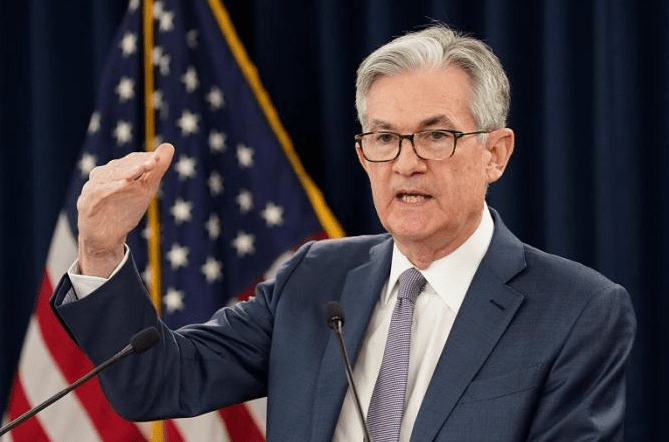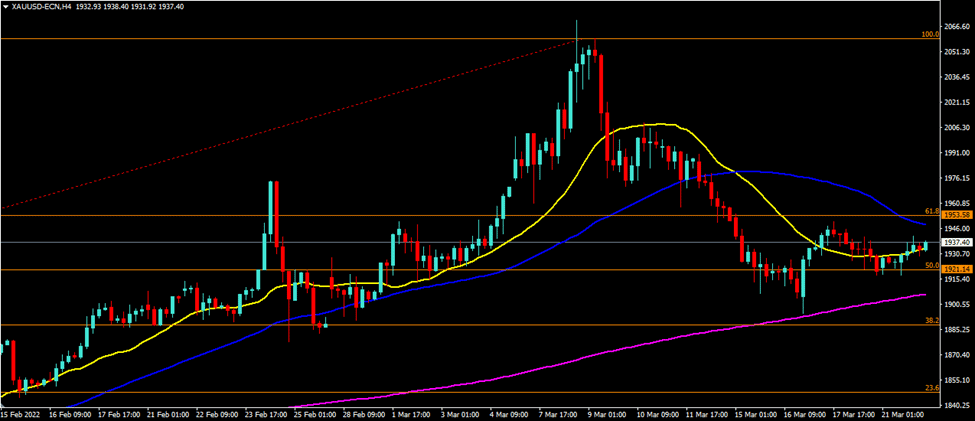On Monday, the US stock market moved marginally lower following Federal Reserve Chairman Jerome Powell’s warning about increasing inflation and the possibility of a half-point rate hike in May. The Dow Jones Industrial Average finished 0.58 percent lower, while the S&P 500 was practically flat, down 0.04 percent. The Nasdaq Composite finished the day down 0.4 percent.
Fed Chair Jerome Powell underlined on Monday that the Fed will continue to fight the rate of inflation in the United States. Powell will not alter his liquidity withdrawal approach, despite market participants’ doubts that rapid interest rate hikes will result in a halt in US GDP. Powell’s assertiveness repressed the US stock market, resulting in another 0.6 percent decline in the Dow Jones index.

The decrease in Wall Street’s capital market is, of course, plagued by the Fed’s determination to hike interest rates six times this year and the Fed’s balance sheet reduction, which now stands at $9 trillion US Dollars. The hike in interest rates and the subsequent shrinkage of the Fed’s balance sheet, which will begin at the Fed’s May 4 meeting, undoubtedly signals that Powell will drain liquidity aggressively in the future, resulting in a deterioration of the US capital market.
Additionally, the accident of a Boeing 737 owned by China Eastern Airlines in the Chinese highlands weighed on Boeing’s shares, adding to the market’s woes yesterday. Boeing stock dropped as much as 3.5 percent, according to reports.
The XAUUSD pair’s negative movement may continue this week, owing to the US Dollar currency index’s ongoing gain following last week’s FOMC meeting. The Fed’s program of raising interest rates from 0.25 percent to 0.50 percent was the primary driver in the market’s decision to hold the US Dollar. The US central bank is expected to hike interest rates at least three times this year, but it is conceivable for the Fed to raise rates more depending on the direction of US inflation, which is presently at 7.9 percent. The US central bank’s policies continued to strengthen the US dollar and reduce global gold prices this week.

Main Pairs Movement
The Japanese yen fell to a six-year low versus the US dollar in response to the Federal Reserve’s aggressive monetary policy. USDJPY closed 0.27 percent higher at 119.47 on Monday. Simultaneously, the Bank of Japan maintained its easing stance, maintaining its interest rates and asset purchase program constant.
WTI gained more than 7% on Monday as the EU considered penalties against Russia’s oil industry following an attack on Saudi Arabian infrastructure by Houthi rebels who professed support for Russia’s invasion. The EU has begun discussing joining the US in an oil embargo because of the move.
Gold edged higher on Monday, settling at $1936 because of the uncertainty surrounding the US President Biden-NATO discussions. Meanwhile, the market has moved its emphasis to the Russia-Ukraine war. Separately, gold gained some momentum following word that the anticipated call between Joe Biden and Xi Jinping failed to produce any significant results.
EURUSD fell 0.32 percent, to 1.10152, to begin the week, as the US dollar strengthened in response to Jerome Powell’s aggressive tone.
Technical Analysis
GBPUSD (4-Hour Chart)

Cable began the week with a gain as demand for the dollar continues to wane. The Bank of England’s most recent interest rate boost provided an adequate upward impetus for the British Pound. The UK’s CPI and PMI statistics are slated for publication on Wednesday and Thursday, respectively; the US’ initial jobless claims and core durable goods data are scheduled for release on Thursday.
Cable has broken over our previously anticipated resistance level of 1.3185 on the technical side, although upward momentum appears to be waning. Cable is currently trading above its 50-day SMA but below its 100- and 200-day SMAs on the four-hour chart.
Resistance: 1.3208
Support: 1.3100, 1.3000
EURUSD (4-Hour Chart)

The euro-dollar pair has maintained the higher price trend we predicted. However, with no end in sight to the Ukraine-Russia war and no sign of progress in the most recent peace talks, market investors should be cautious of probable short-term trend reversals. Fed Chairman Jerome Powell stated during his scheduled address during the US session that inflation was running faster than expected and that the central bank would not rule out a 50-basis point rate hike.
On a technical level, the EURUSD has successfully defended our previously anticipated support level at 1.0893, while the immediate resistance level at 1.1127 remains untested. As of this writing, the pair’s RSI stands at 40.07. EURUSD is currently trading below its 50-day, 100-day, and 200-day SMAs on the four-hour chart.
Resistance: 1.1008, 1.1067
Support: 1.0930
XAUUSD (4-Hour Chart)

Gold began the week trading higher relative to the previous week’s closing. With the Kremlin and Kyiv refusing to back down, market participants will continue to monitor the growing scenario while using gold as a hedge against geopolitical tensions. Recent interest rate hikes by central banks throughout the world have also aided the precious metals boom. Recently, the Russian army used hypersonic weapons capable of carrying nuclear warheads to demolish tactical positions. This move has alerted worldwide defense ministries, as such weapons have not been used since the outbreak of the Ukraine-Russia war.
On a technical level, our previously anticipated support level of $1918 per ounce remains in place. On the other hand, the XAUUSD’s near-term resistance barrier has established near the $1940 per ounce price level. XAUUSD is currently trading below its 50-day and 100-day SMAs but above its 200-day SMAs on the four-hour chart.
Resistance: 1953
Support: 1921